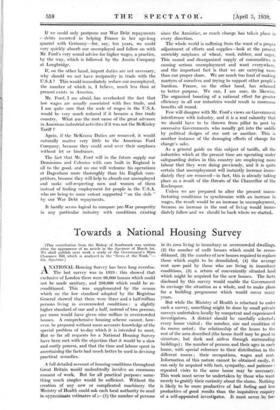Towards a National Housing Survey
[This contribution from the Bishop of Southwark was written after the appearance of an article in the Spectator of March -1st. We shall publish next week a study of the Government's Slum Clearance Bill, which is analysed in the "News of the Week."— ED. Spectator.] - ANATIONAL Housing Survey has been long overdue. The last survey was in 1919 : this showed that exclusive of London there were 96,000 houses which could not be made sanitary, and 203,000 which could be re- conditioned. This was supplemented by the census which on the low standard adopted by the Registrar General showed that there were three and a half million persons living in overcrowded conditions : a slightly higher standard of one and a half, instead of two persons, per room would have given nine million in overcrowded houses. A comprehensive housing scheme cannot, how- ever, be prepared without more accurate knowledge of the special problem of to-day which it is intended to meet. But so far all requests for a National Housing Survey have been met with the objection that it would be a slow and costly process, and that the time and labour spent in ascertaining the facts had much better be used in devising practical remedies.
A full detailed account of housing conditions throughout Great Britain would undoubtedly involve an enormous amount of work. But for all practical purposes some- thing much simpler would be sufficient. Without. the creation _ of any new or complicated. machinery - the Ministry of Health could ask each local authority to send in appreximate estimates of l--(1) the number of persons in its area living in insanitary or overcrowded dwellings, (2) the number of unfit houses which could be recon- ditioned, (3) the number of new houses required to replace those which of to be demolished, (4) the average rent now paid by those who are living in insanitary conditions, (5) a return of conveniently situated land which might be acquired for the new houses. The facts disclosed by this survey would enable the Government to envisage the situation as a whole, and to make plans for a building programme which would cover many years.
But while the Ministry of Health is reluctant to order such a survey, something might be done by small private surveys undertaken locally by competent and experienced investigators. A district should be carefully selected.; every house visited ; the number, size and condition of its rooms noted ; the relationship of the house to the rest of the area described (the house itself may be good in structure, but dark and airless through surrounding buildings) ; the number of persons and their ages in each house, with special reference to their distribution in the different rooms ; their occupations, wages and rent. Information of this nature cannot be obtained easily, it can only be acquired with tact, sympathy, and patience : repeated visits to the same house may -be necessary. This work must never be undertaken by those who want merely to gratify their curiosity about the slums. Nothing is likely to be more productive of bad feeling and less productive of good results than the inquisitive enquiry of a self-appointed investigator. It must never be for- gotten that the slum dweller has as much right to privacy in his or her home as the tenant of a suburban house. Far more harm than good will be done by the foolish or patronizing enquirer. But surveys carried out thoroughly and sympathetically will give some, at any rate, of the information which should have been gained by a National Survey. The facts discovered will do more than anything else to arouse the public conscience to the urgent need of immediate and drastic action ; statistics fail to appeal to sympathy unless they are clothed with descriptions drawn from life. Even an incomplete, but, so far as it goes, an accurate, account of overcrowded or insanitary con- ditions will convey valuable information.
Here is such an account of a house sent to me a few days ago. " A seven roomed house : average size of rooms 10 feet by 10 feet. Inhabited by 33 people as follows Attic floor :-2 tiny back rooms : man, wife and three children. 1 front room : man, wife and three children.
First floor :—Front room : man, wife and three children. Back room : man, wife and seven children, ages varying from 13 to a few months.
Ground ,Moor :—Front room : man, wife and five children. Back room : man, wife and one child. Total 14 adults, 19 children.
One w.c. and one-water tap for the whole house. Sanitary conditions in this terrace are appalling. Very few houses have a dustbin. None has more than one w.c. and one water-tap. Some w.c.'s have long been out of order. Basement washhouses are frequently ankle- deep in water. Some houses are rat-infested, most of them are bug-ridden, and beetles have lately made their appearance in formidable numbers. Many of the houses have defective fire places."
This survey is not complete. It gives neither the occupation nor the wages of the tenants. It omits any mention of the rent. But notwithstanding these serious omissions it gives a vivid picture of conditions in a slum house and is more likely to stir indignation and sympathy than rows of tabulated statistics.
CYRIL SOUTHWARK.











































 Previous page
Previous page